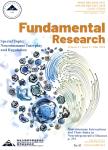Adaptively temporal graph convolution model for epidemic prediction of multiple age groups
作者机构:The State Key Laboratory of Management and Control for Complex SystemsInstitute of AutomationChinese Academy of SciencesBeijingChina School of Artificial IntelligenceUniversity of Chinese Academy of SciencesBeijingChina Shenzhen Artificial Intelligence and Data Science Institute(Longhua)ShenzhenChina School of Data ScienceCity University of Hong Kong-Hong Kong SARChina Institute for Infectious Disease and Endemic Disease Control Beijing Center for Disease Prevention and ControlBeijingChina
出 版 物:《Fundamental Research》 (自然科学基础研究(英文版))
年 卷 期:2022年第2卷第2期
页 面:311-320页
学科分类:1004[医学-公共卫生与预防医学(可授医学、理学学位)] 100401[医学-流行病与卫生统计学] 10[医学]
基 金:This work was supported in part by grants from the National Natural Science Foundation of China(Grants No.72025404 and 71621002) Beijing Natural Science Foundation(Grant No.LI92012) Beijing Nova Program(Grant No.Z201100006820085).
主 题:Graph convolution model Infectious disease prediction Multiple age group Multivariate time series Public health
摘 要:Introduction:Multivariate time series prediction of infectious diseases is significant to public health,and the deep learning method has attracted increasing attention in this research field.Material and methods:An adaptively temporal graph convolution(ATGCN)model,which leams the contact patterns of multiple age groups in a graph-based approach,was proposed for COVID-19 and influenza prediction.We compared ATGCN with autoregressive models,deep sequence learning models,and experience-based ATGCN models in short-term and long-term prediction tasks.Results:Results showed that the ATGCN model performed better than the autoregressive models and the deep sequence learning models on two datasets in both short-term(12.5%and 10%improvements on RMSE)and longterm(12.4%and 5%improvements on RMSE)prediction tasks.And the RMSE of ATGCN predictions fluctuated least in different age groups of COVID-19(0.029±0.003)and influenza(0.059±0.008).Compared with the Ones-ATGCN model or the Pre-ATGCN model,the ATGCN model was more robust in performance,with RMSE of 0.0293 and 0.06 on two datasets when horizon is one.Discussion:Our research indicates a broad application prospect of deep learning in the field of infectious disease prediction.Transmission characteristics and domain knowledge of infectious diseases should be further applied to the design of deep learning models and feature selection.Conclusion:The ATGCN model addressed the multivariate time series forecasting in a graph-based deep learning approach and achieved robust prediction on the confirmed cases of multiple age groups,indicating its great potentials for exploring the implicit interactions of multivariate variables.



